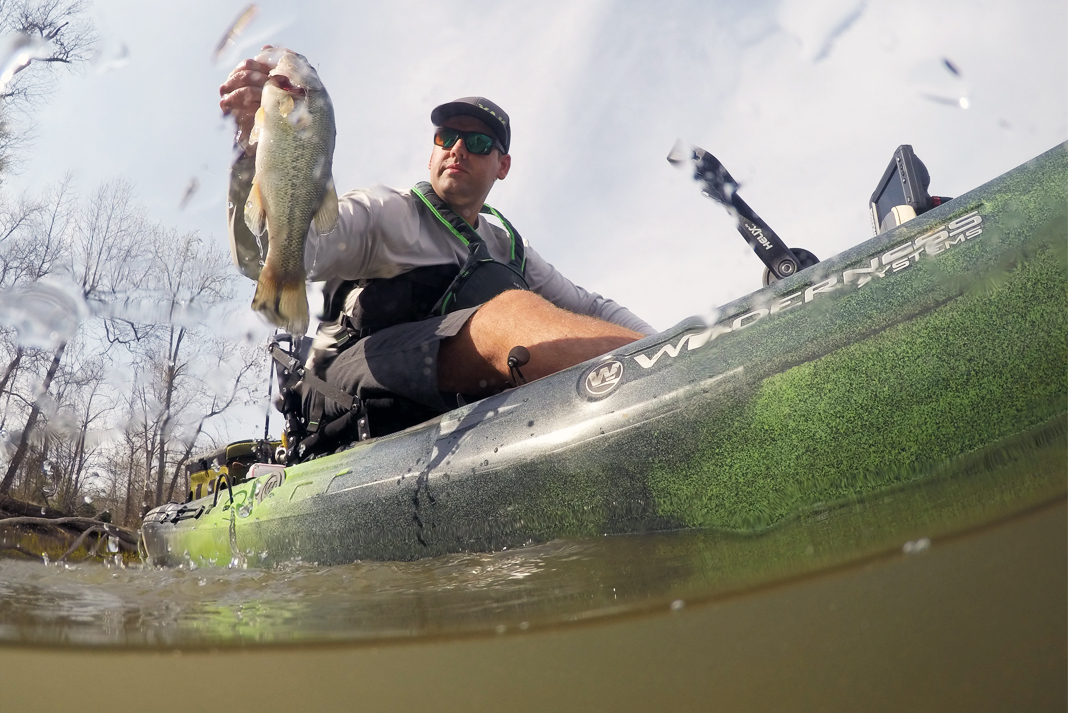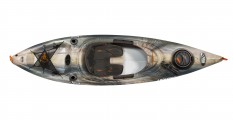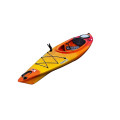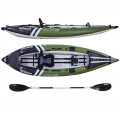Every style and size of fishing kayak has its place, including 10-foot fishing kayaks. While long, narrow fishing kayaks are meant for tearing across open water and swells, 10-foot fishing kayaks are most at home on a winding river, your local lake or a tight meandering estuary.
Ten-foot fishing kayaks have advantages. They are generally easier to maneuver, lighter to transport and less expensive than their larger counterparts. The most common type are sit-on-top kayaks with a molded-in seating area and on-deck storage.
Finding the right 10-foot fishing kayak is no small task. Consider the size of the field. The popularity of 10-foot fishing kayaks means kayaks in this range are offered by many brands. In this article about best 10-foot fishing kayaks we’ll discuss what’s on the market, suggest best buying strategies and answer some questions we know you have on your mind when it comes to 10-ft kayaks for fishing.
Top picks: Best 10-foot fishing kayaks for 2024
The following 10-foot fishing kayaks have received the highest star ratings by reviewers in our Paddling Buyer’s Guide. See and review all 10-foot fishing kayaks here.
Best 10 Foot Fishing Kayaks
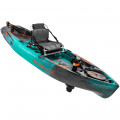
Sportsman PDL 106
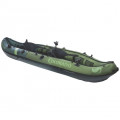
Colorado

Blackfoot Angler 130
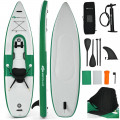
11' Sit-On-Top Inflatable Kayak
Shop for 10-foot fishing kayaks
How do the kayaks of each brand stack up? Where can I find a list of 10-foot fishing kayaks available at popular retail stores? In our Paddling Buyer’s Guide we’ve filtered these fields for the class of 10-foot fishing kayaks. Below we’ve included links to each which will bring you to our in depth list of available boats, along with specs, prices and reviews of each model.
Shop by type
Shop by brand
Ascend 10-foot fishing kayaks
Feelfree 10-foot fishing kayaks
Intex 10-foot fishing kayaks
Lifetime 10-foot fishing kayaks
Native Watercraft 10-foot fishing kayaks
NuCanoe 10-foot fishing kayaks
Pelican 10-ft fishing kayaks
Perception 10-foot fishing kayaks
Sun Dolphin 10-ft fishing kayaks
Vibe 10-foot fishing kayaks
Shop by store
Shopping for a used 10-foot fishing kayak?
Buying a used kayak can be tricky business but can also be a great way to score a deal. Here are a few specific tips to keep in mind when searching for the best 10-foot fishing kayak.
- Research the brand. The 10-foot range of fishing kayaks is crowded with both high-caliber and low-cost brands. Research a brand before committing to a used purchase and have an idea of where they reside in the marketplace.
- Cost of new vs used. Ten-foot fishing kayaks are some of the most affordable on the market. Ask yourself if the wear and tear that comes with a used boat is worth the discount you will be getting?
- Is this kayak stable for your intended use? A smaller kayak means less surface area making contact with the water. Depending on the design, this often translates to less stability. Always take a used kayak for a test paddle to see if it is comfortable for you before buying.
For more tips on what to look for when selecting a used fishing kayak, read our article How To Buy A Used Fishing Kayak.
10-foot fishing kayak buying advice
When buying a 10-foot fishing kayak you will be looking for many of the same elements you would when purchasing a fishing kayak in general. However you will also want to keep in mind design elements and outfitting features which will be specific to the kayak’s shorter size.
You are likely purchasing a 10-foot fishing kayak for one of a few reasons. The waterways you are paddling require maneuverability; storage space for your kayak and ease of transport are a priority; or maybe you have a limited budget and 10-foot kayaks tend to cost less.
If you are purchasing a fishing kayak for smaller waterways or rivers requiring maneuverability, you should also keep in mind just how slippery you would like your fishing kayak to be. When deciding on the best 10-foot kayak for fishing your waters, consider the tracking ability of the kayak. This is the kayak’s ability to travel in a straight line without correction strokes.
A kayak with no tracking ability will continually spin on the surface of the water. This can make it difficult to concentrate on fishing when you are constantly reaching for your paddle. A shorter kayak will generally not track as well as a longer kayak, but there are other design elements like pronounced keel lines or skegs which can improve tracking ability.
If you are using the kayak on rocky rivers with mild rapids and planning to be making many maneuvers, then responsiveness may trump tracking on your priority list.
If you plan to paddle flatwater or slow moving water and want some tracking ability, be sure your kayak has features such as a skeg or deployable rudder system to assist with tracking.
For those seeking a 10-foot fishing kayak for other reasons such as size or budget, you may also want to consider the cargo-hauling capability of the kayak. After all, you may be buying a smaller fishing kayak, but you still have tackle to carry.
Measure the dimensions of the crates, boxes, or bags you plan to haul on your outings and be sure the 10-ft fishing kayak you are considering is able to accommodate. Most fishing kayak storage, especially with sit-on-top kayaks comes in the form of tankwells on the deck of the kayak.
If possible, always take the kayak you are considering for purchase for a test spin. You can do all the online research you like, but getting out on the water is the only way to know for sure if a kayak is for you.
-
10-foot vs 12-foot fishing kayak
Deciding between a 10-foot vs 12-foot fishing kayak will largely depend on where you plan to fish with the kayak. A 10-ft fishing kayak works well on rivers and in tight waterways where maneuverability is the most important factor. In exposed waterways with wind, current, and waves, a 12-foot fishing kayak provides more speed, tracking and surface area for stability.
Also check the capacity for each kayak. Larger paddlers may choose a 12-foot fishing kayak to provide a safer and more comfortable ride, as well as extra room to load gear.
The two-foot difference between a 10-foot and 12-foot fishing kayak, will affect the weight of the kayaks, which may be a factor for you while transporting it.
-
Is a 10-foot kayak long enough?
The proper length of the kayak you choose depends on the type of waterways where the kayak will be used as well as the paddler’s dimensions.
For rivers and tight waterways where maneuverability is the most important factor, a 10-foot fishing kayak is long enough. If you are in more exposed waterways, and will face strong wind and current, then a 10-foot kayak may not provide enough speed and tracking ability.
-
Can a 10-foot kayak fit in a minivan?
A 10-foot fishing kayak will often fit in a minivan, though it will likely be a tight fit.
First, measure from the passenger-side dashboard to the rear hatch of the car to be sure you have the length. Fold all the seats to create as flat a space as possible. When placing the kayak in your minivan you may have to angle or lift it slightly to make it fit. Be sure the kayak is not laying in a way it could slide and hit the windshield during a hard brake.
-
Can I put a 10-ft kayak in an SUV?
You may be able to put a 10-ft kayak in your SUV depending on the interior length. The best way to check is measuring from the dashboard to the rear of the car to see if you have enough length. If your rear window opens you can also have some of the kayak sticking out of the back.
-
How do you carry a 10-foot kayak?
There are multiple ways you can carry a 10-foot kayak. How you carry the kayak will also depend on the kayak weight and where the handles have been placed.
If you are paddling with a partner the easiest way is to carry both kayaks together at the same time. Line the kayaks up beside each other, then one paddler grabs both bow handles and the other paddler grabs both stern handles.
If the kayak is light enough, and has a side handle you can pick it up like a suitcase. If it is light enough and has a deep enough cockpit or a thigh strap you can rest the kayak on your shoulder and walk with it.
If the kayak is heavy, or there is no good way to lift it on your own, the best option is to use a cart or wagon to transport your 10-foot fishing kayak.
-
Lightest 10-foot fishing kayak
The lightest 10-foot fishing kayak available is likely an inflatable such as the Intex Excursion Pro. However inflatables don’t offer the durability and performance-enhancing rigidity of a hard-shell, plastic kayak. Kayaks built using thermoforming are generally the lightest plastic kayaks. Examples of brands that use thermoforming include Pelican and Eddyline.
-
Most stable 10-foot fishing kayak
As a general rule a wider kayak will provide more stability. Also, when comparing hull types, pontoon-style hulls are often the most stable 10-ft fishing kayaks.
10 ft fishing kayak reviews
Finding the best 10-foot kayak for fishing will take some research. You’ll want to know the nuts and bolts of the kayak, background on the brand and a good overall idea of the type of experience a fishing kayak will offer. Here you will find our comprehensive reviews of each 10-foot fishing kayak. We break down these different topics. We also offer specifications and places where each of these kayaks is available for sale.
- Kayak Review: Sun Dolphin Excursion 10
- Fishing Kayak Review: Ascend FS10
- Fishing Kayak Review: Old Town Vapor 10
- Fishing Kayak Review: Ascend 10t
- Fishing Kayak Review: Pelican Mustang 100x
- Fishing Kayak Review: Old Town Sportsman 106 Minn Kota
- Recreational Kayak Review: Pelican Bandit NXT 100



